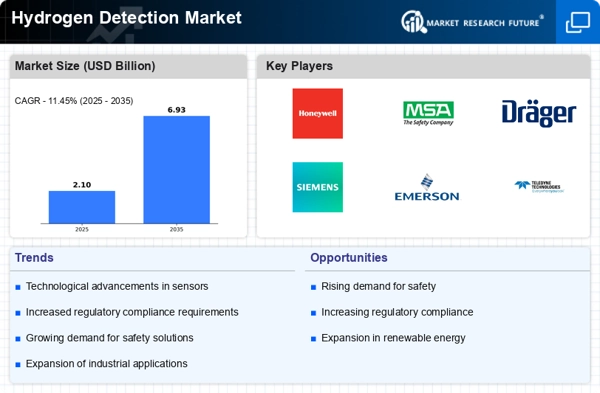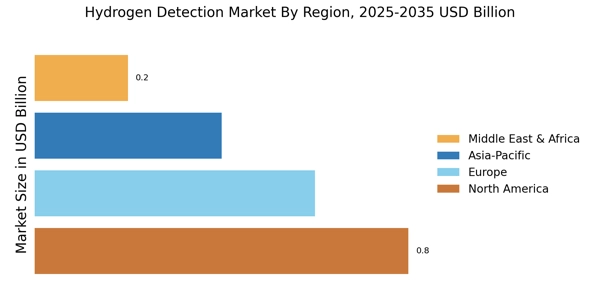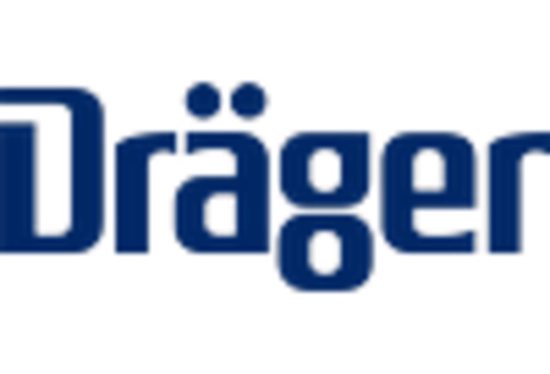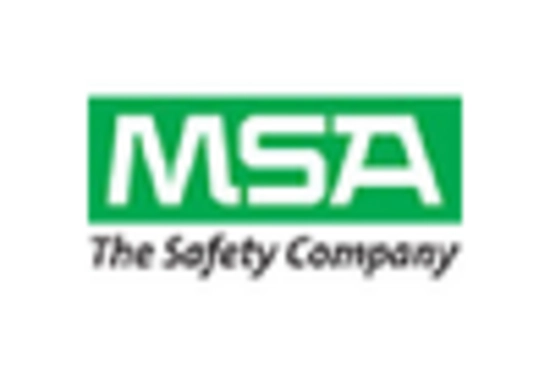Increasing Demand for Safety Solutions
The Hydrogen Detection Market is experiencing a notable surge in demand for safety solutions across various sectors, including oil and gas, chemical manufacturing, and automotive. As industries increasingly recognize the potential hazards associated with hydrogen, the need for reliable detection systems becomes paramount. According to recent data, the market for hydrogen detection systems is projected to grow at a compound annual growth rate of approximately 7.5% over the next five years. This growth is driven by the rising awareness of safety protocols and the implementation of stringent safety regulations. Companies are investing in advanced detection technologies to mitigate risks, thereby enhancing workplace safety and compliance. The Hydrogen Detection Market is thus positioned to benefit from this heightened focus on safety, as organizations prioritize the protection of personnel and assets.
Growing Awareness of Environmental Impact
The Hydrogen Detection Market is also being driven by a growing awareness of environmental impacts associated with various industrial processes. As stakeholders become more conscious of their carbon footprints, there is a heightened focus on adopting cleaner technologies, including hydrogen. This shift is prompting industries to implement stringent safety measures, including the installation of hydrogen detection systems. The market is expected to grow as organizations recognize that effective detection not only enhances safety but also aligns with their sustainability goals. Furthermore, the increasing pressure from consumers and regulatory bodies to adopt environmentally friendly practices is likely to propel investments in hydrogen detection technologies. As a result, the Hydrogen Detection Market is set to expand, reflecting the broader trend towards sustainability and environmental responsibility.
Regulatory Frameworks and Compliance Standards
The Hydrogen Detection Market is significantly influenced by the establishment of regulatory frameworks and compliance standards aimed at ensuring safety in hydrogen handling and usage. Various governmental bodies are implementing stringent regulations that mandate the use of hydrogen detection systems in high-risk environments. For example, regulations from occupational safety administrations require regular monitoring of hydrogen levels in industrial settings. This regulatory push is likely to drive the adoption of detection technologies, as companies strive to meet compliance requirements. The market is expected to expand as organizations invest in reliable detection systems to avoid penalties and enhance safety measures. The increasing complexity of regulations may also lead to a rise in demand for consulting services within the Hydrogen Detection Market, further contributing to its growth.
Technological Innovations in Detection Systems
Technological advancements are playing a crucial role in shaping the Hydrogen Detection Market. Innovations such as the development of more sensitive and accurate sensors are enhancing the effectiveness of hydrogen detection systems. For instance, the integration of IoT technology allows for real-time monitoring and data analysis, which can significantly improve response times in case of hydrogen leaks. The market is witnessing a shift towards smart detection systems that not only identify hydrogen presence but also provide predictive analytics to prevent potential hazards. This trend is expected to drive market growth, with estimates suggesting that the adoption of advanced technologies could increase market revenues by over 20% in the coming years. As industries seek to modernize their safety protocols, the Hydrogen Detection Market stands to gain from these technological innovations.
Rising Adoption of Hydrogen as an Energy Source
The Hydrogen Detection Market is poised for growth due to the rising adoption of hydrogen as a clean energy source. As countries and industries shift towards sustainable energy solutions, hydrogen is increasingly recognized for its potential to reduce carbon emissions. This transition necessitates the implementation of effective hydrogen detection systems to ensure safety in production, storage, and transportation. The market is projected to witness a compound annual growth rate of around 8% as more organizations integrate hydrogen into their energy portfolios. The need for robust detection systems becomes critical in this context, as the risks associated with hydrogen handling must be managed effectively. Consequently, the Hydrogen Detection Market is likely to benefit from this trend, as investments in safety technologies increase alongside the growth of the hydrogen economy.

















Leave a Comment